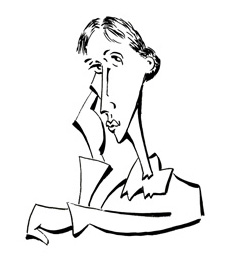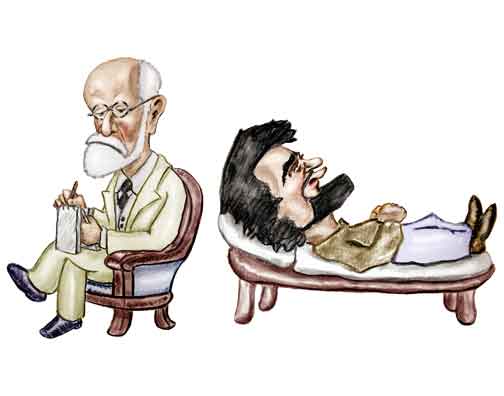Virginia Woolf

Virginia Woolf
Passive entertainment a modern invention? Au contraire, as Virginia Woolf might say. Before the Internet, television, and radio there were plenty of people who would sit at home by themselves for hours on end. There were, after all, those non-electronic devices with white flappy things in the middle that could occupy your time for hours on end. Some people read them. Others, like Virginia, wrote and published them.
Virginia Stephen was born in 1882 at the beginning of the end of the Victorian era (which lasted until 1901). Her father and mother were artistic and literary people, and her dad, Leslie, was the editor of the Dictionary of National Biography. Her mom, Julia, although a quintessential Victorian lady, also wrote children's stories as well as posing as a model for the artists of the day. Good heavens, no! She didn't stand in front of the easel in her all-together. That was not a proper activity for a Victorian lady and mother. But she did stand-in when the artists needed a ethereal and robe-bedecked lady to illustrate the romantic days of King Arthur and the Knights of the Round Table. You've probably seen her in paintings by Dante Gabriel Rossetti, George Frederick Watts, and other famous artists you've never heard of.
Leslie allowed his daughter into his extensive library, although if it was a typical Victorian book-room, some of the volumes were not exactly children's literature. There is one story of how a British nobleman had died and when his wife went to take an inventory of his library, she was shocked! shocked! at the type of books His Lordship had collected. Some books even had pictures. She called one of the major booksellers and publishers of the day, Leonard Smithers, and told him to "take them away". Leonard did quite happily, having previously sold the books to his Lordship at a handsome profit.
But Virginia never really had a formal education, although her brothers went to the best public schools (ergo, a private school in the US) and then to Cambridge University. This was a time when double standards based on gender were not only accepted but considered right. Although Virginia later took classes at the women's division of King's College at the University of London, she was always irked that she was denied equal access to what were England's considerable educational opportunities.
Virginia's mom died in 1895 and her dad in 1904. The Stephen brothers and sisters moved into a house in the Bloomsbury section in the center of London which was known as a cool place for artists, writers, and other "bohemians". The kids made a lot of friends, and the group of people who met at Bloomsbury are now known as the Bloomsbury Group (this was the day when people called a spade a spade). Many of the Group were to make quite a splash in the world, including economist John Maynard Keynes. Others, like writer Lytton Strachey, became so famous that today most people have never heard of them.
One of the visitors to Bloomsbury was a young swain named Leonard Woolf who in 1904 was just heading off to serve in the civil service in Ceylon (now Sri Lanka). After he returned in 1911, he and Virginia married. Being surprisingly traditional in some ways, Virginia began writing under her married name.
While living in Bloomsbury, Virginia began writing literary reviews in 1904 and by 1905 was writing articles for the London Times - not a bad achievement for a 23 year old lady of the era. She also began writing fiction, and it's very possible she could have found a mainstream publisher for her novels (she was, in fact, published in the United States by the prestigious Harcourt-Brace).
But Virginia and Leonard set up their own publishing company, Hogarth Press, Ltd. It started out more or less as a hobby - they only had a hand press - and Virginia set the type (by hand) and Leonard cranked the press. By necessity the volumes were short - sometimes only a couple of stories.
But people began buying the books and eventually Hogarth became a business which in some years made a good profit. Of course, with just a hand press they couldn't hope to be a real business and their commercial books were printed by larger firms on contract. Hogarth Press issued not only Virginia and Leonard's books, but other non-mainstream authors as well. These included T. S. Eliot (they printed The Waste Land), Robert Graves, John Maynard Keynes, Gertrude Stein, H. G. Wells, and Sigmund Freud. It is a bit ironic that it was Sigmund who was Virginia's client. They were offered but turned down James Joyce's Ulysses.

Sigmund: Virginia's Client
Virginia's own books deal not unexpectedly with people trying to break free from the norms of the time and her stories departed in content and style from the popular Victorian novels. Charles Dickens wrote books whose plots extended over decades (and when assigned as classroom reading, it sure seems that way). But some of Virginia's books only covered the span of a day.
You can find many of Virginia's books for sale both in print and in electronic formats and in some countries not bound by the Mickey Mouse Protection Act, they are available online. As is typical for readers of "classic" works, the readers respond to Virginia's novels with considerable variety. To some they remain top notch literature which addresses issues which are still relevant today. Yet others find it hard to manage the first few pages and wonder" This is by one of the greatest writers in history?"
There have been movies and television shows (actually both) made from Virginia's most famous books, including Mrs Dalloway and To the Lighthouse. Virginia herself shows up as a character in a Sherlock Holmes novel, "The Case of the Philosopher's Ring" by Randall Collins (now Dorothy Swaine Thomas Professor of Sociology at UPenn). The basic plot is the philosopher and mathematician Bertrand Russell hired Sherlock Holmes to locate Ludwig Wittgenstein. Virginia and Lytton show up in a very brief scene.
Virginia had always been plagued with what are now called extreme mood swings, where she would wax enthusiastically about what interested her and then crash to silence that would last for days and even lapse into delirium. By early 1941, she would sometimes hear voices and was afraid she was going insane.
Given the way each edition of the DSM keeps changing how to detect or even define a particular mental illness, it's no surprise that today psychiatrists say that hearing voices is not something people necessarily should be alarmed at, particularly since "hearing voices" is pretty broadly defined and is not limited to actual auditory hallucinations. Perceiving wayward intrusive thoughts which seem to come from outside your voluntary consciounness may sometimes be considered "hearing voices", and there are even support organizations for "voice-hearers" as they preferred to be called.
But back in 1941, hearing voices was still considered the hallmark of insanity. So on March 28, Virginia put on an overcoat, filled her pocket's with rocks, and walked into the Thames. She wasn't found for another month although stories of her disappearance (and presumed death) were published in the world's presses.
References
Virginia Woolf, Hermione Lee, Knopf, 1997.
"Seventy Years at the Hogarth Press: The Press of Virginia and Leonard Woolf", Special Collections Gallery, Exhibited May 15 - September 30, 1987, Curated by Max Yela, Special Collections Department, Hugh H. Morris Library, University of Delaware, http://www.lib.udel.edu/ud/spec/exhibits/hogarth/